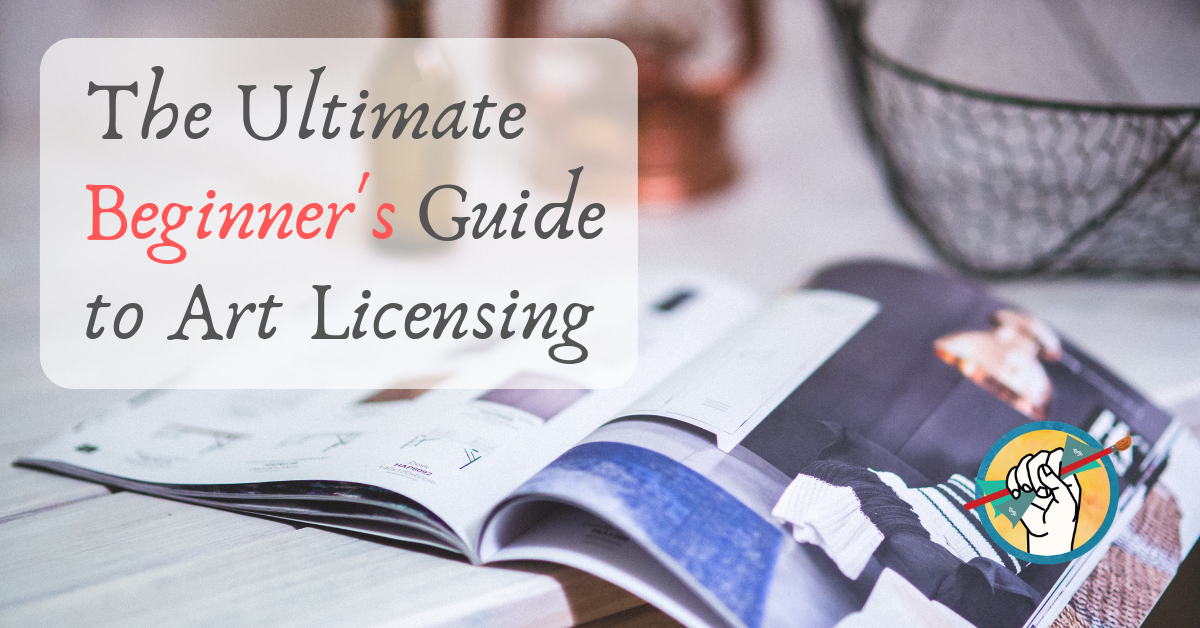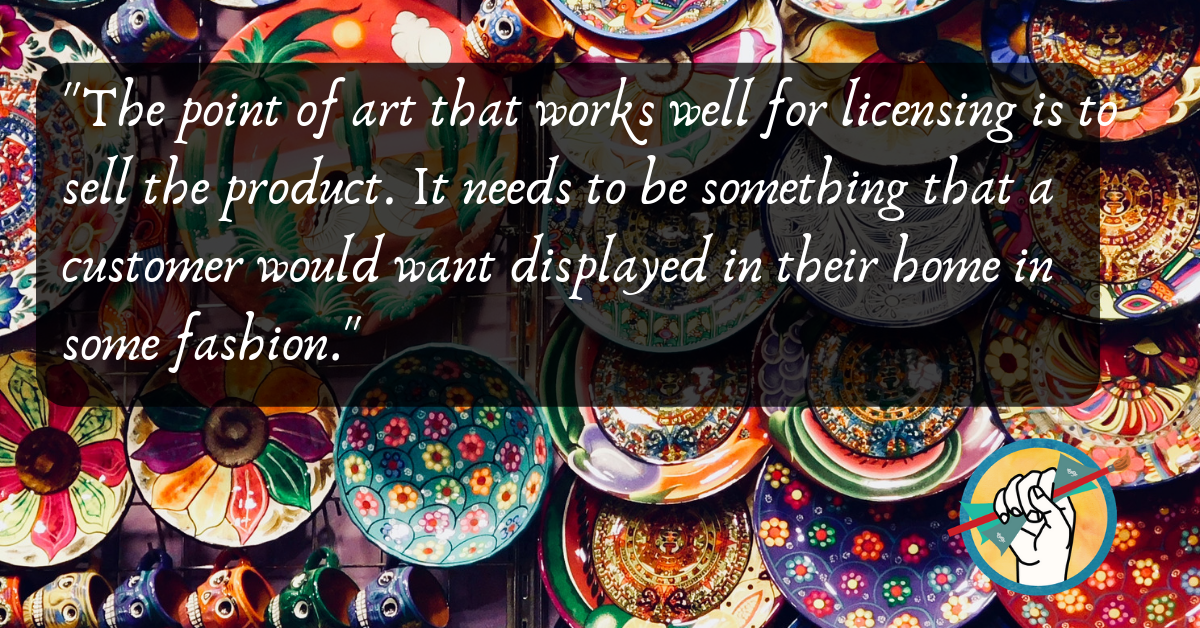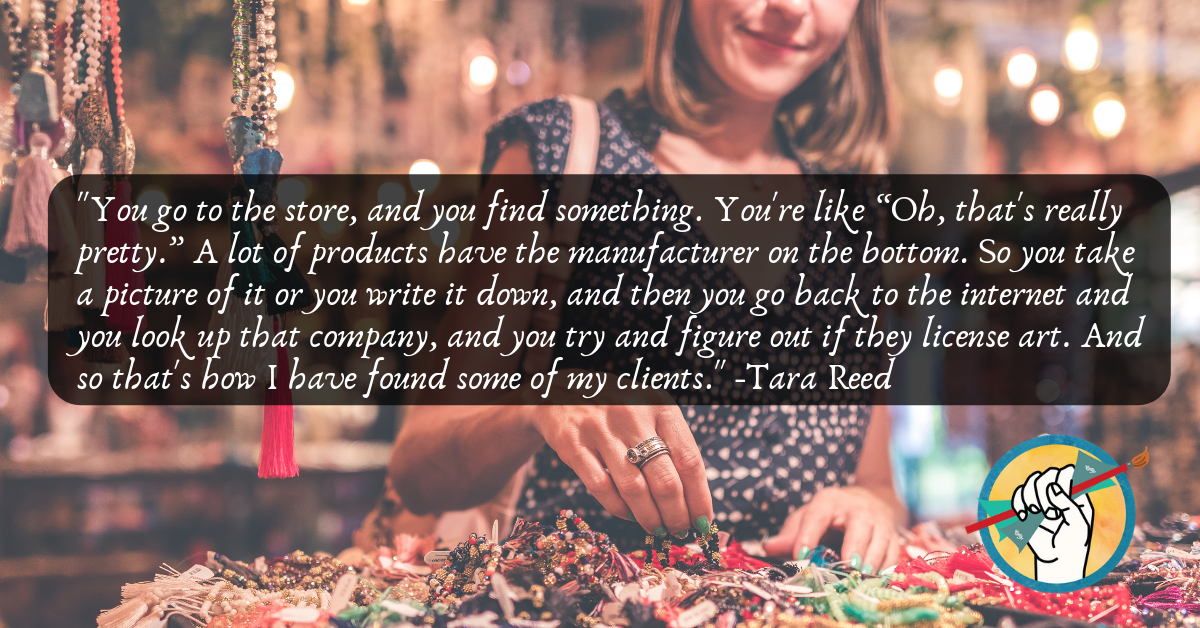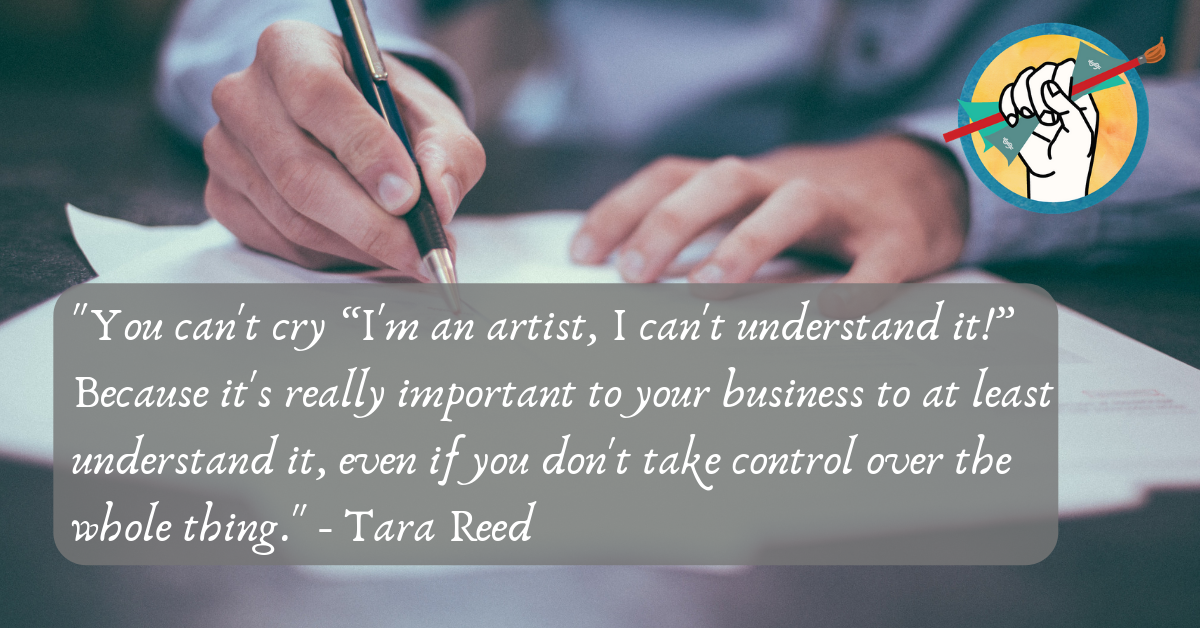Do You Need a License to Be an Art Instructor
At The Abundant Artist, we are passionate about teaching artists that it is entirely possible to make money from your fine art, even outside of the traditional gallery system. In fact, many of our artists make a living from their work without ever setting foot in a gallery. A seldom-discussed aspect of the art industry, and somewhat mysterious to many artists, is art licensing. While it's non for everyone, information technology is a facet of the industry well worth exploring for artists who are well experienced with managing their budget and are interested in collaborating with corporations.
Several years ago, Cory interviewed an artist who licenses her art with a broad variety of companies and who founded ArtLicensingInfo.com. Tara Reed is a licensing expert with years of feel, so we use transcribed portions from our interview with her throughout this article, lightly edited for readability.

What is art licensing?
Art licensing is a manner of making coin wherein, as licensing expert Tara Reed puts information technology, you "rent" your artwork to companies to put on their products. An artist who chooses to license their art may not sell any originals at all, but merely license the images for use on commercial products. There is tremendous potential in the world of art licensing, but it requires a dissimilar fashion of approaching business than more traditional avenues of selling art such as selling originals and prints through galleries or direct to collectors.
Are you willing to interact with a third party on every piece of art you license?
Tara Reed gives u.s.a. a rundown on the basic steps involved in an art licensing transaction:
"In our perfect world… I was only working on this drove this morning of art, and I'll finish it probably tomorrow and I'll get-go sending information technology out to a couple of clients that I work with all the time. One or two of them might be similar "Oh yep, we similar it. Send us the files, nosotros'll knock something upwardly and see what happens."
And then I've done the art, they're now going to consider it. A lot of what goes on in the industry now, information technology'due south a little different than ten years ago, is they store your art. So they might show it to some of their key accounts, they might show it to a large business relationship similar Bed Bathroom and Across or whatever. They often won't commit to you until they know they're going to have decent placement. A petty different than in years past. So they have to mock stuff up, they have to evidence it to people. So, okay, it's beautiful, somebody wants it. Then you're going to exercise the contract. If I've never worked with them before, nosotros have to start from scratch. If it's a company I've worked from we have a basic contract, we'll practice an amendment where we add "Okay, yeah, at present you lot're licensing this fine art in add-on to what you've already done in the past." And so you always have to do the contract matter. Then they have to produce information technology, they have to sell information technology if it'due south going into mom-and-pop stuff, or they have to ship it, whatever. It can take, I think nine months is the shortest amount of time between when I end something and when it has shipped. And you don't get paid until the quarter subsequently it ships."
How does art licensing work?
Companies that sell housewares, clothing, decor, kitchenwares, etc to retailers demand cute art to put on their merchandise. Where exercise they source that art? While some companies have in-firm designers and artists, many source their art from freelance artists. What many artists don't realize about the art licensing process is that it is not normally a simple procession from finished artwork to expensive licensing deal.
So this is the first question to inquire yourself if y'all are interested in licensing your art: are y'all willing to interact with a third party on every piece of art you license? Tara Reed describes a typical instance of receiving feedback from a customer:
"Perfect case in signal… chalkboard is actually popular right now. If yous're on Pinterest at all, yous come across chalkboard stuff everywhere. So I've been playing a piffling flake with the chalkboard trend with art that I like. Then I did this one thing, and I sent it send it to one of my clients who does wall fine art. And I'grand similar, "Okay. I think this might exist absurd. It'south kind of a combination of a chalkboard, and folksy." And she writes me dorsum, "It's a absurd idea. Merely it's too dark. I desire a white background, I want brighter xanthous, I want a lime green." Basically, okay, yous like the image simply aught else about information technology. Information technology is so rare to show somebody something and accept them say "Perfect, send information technology over." There'south virtually always a change. 90 to 95 percent of the time there's a alter. In this particular case I pretty much said "Okay, you similar the theme. But y'all don't similar how I did it. Just I'm gonna finish doing it this style, see how information technology goes, and then I'll let you know when I do a lighter, brighter version of the theme."
In that location are some artists who bristle at the thought of receiving creative feedback from a corporate entity, even an art manager, who has been removed from the process of creating the piece and may not identify with (or even particularly care about) the heart or message behind it. Other artists, such as professional illustrators, will read about Tara's experience and say "Yep, that sounds about right."
It is so rare to prove somebody something and have them say "Perfect, send it over." There's well-nigh e'er a change.
Here is how Fine art Licensing Info puts it in a section titled The Basics of Art Licensing:
"For those individuals who are willing to piece of work difficult to create the necessary collections of art needed by manufacturers, to work with the legalities of a contract, who are willing to continually market themselves and their works, and willing to piece of work nether a system that does not guarantee immediate income for the work being done, art licensing may be the route to take."
So what are those "necessary collections of art"?

How do you create fine art manufacturers volition want to license?
Art that sells well on manufactured items is art that both manufacturers and customers tin can chronicle to, according to Tara Reed. The point of fine art that works well for licensing is to sell the product. It needs to be something that a client would want displayed in their dwelling house in some fashion. Accept a look around your ain home and notice what products you've purchased with artwork on them without really thinking near it: kitchen towels, tablecloths, cookie jars, clocks and wall art, placemats, etc. The art on licensed products may vary wildly from home to abode, only it will have some factors in common such as existence a coherent serial as well as bonny and appealing to the eye.
For this purpose, there are probable to exist some perfectly valid art series that are not a skilful fit for licensing: overly political pieces, multimedia or 3-dimensional art, sculpture, etc.
If yous've gotten this far and have decided that you're interested in collaborating with corporate clients and you have serial of art that may be a adept fit for licensing, the next step is to figure out how to get started. Starting time, check out Tara Reed's article The Art of Creating Fine art Licensing Collections.
How exercise you get started licensing your art?
This is i of the most mutual questions from artists who are overwhelmed past the prospect of art licensing. How does one even begin to dip their toe into the vast and seemingly complicated globe of art licensing? Once again Tara Reed has come to the rescue, with a really helpful research tactic she uses in order to find manufacturers who may want to license her work:
"It's chosen shopping research, and information technology doesn't cost you anything. You go to the store, and you notice something. You're like "Oh, that's actually pretty." A lot of products take the manufacturer on the bottom. So y'all take a picture of it or you write it down, and then you become back to the internet and yous look upwards that company, and yous try and effigy out if they license art. And so that's how I have found some of my clients.
Some you'll become to their website and it'll say "Artist Submissions." So that's crawly, considering they tell you how they want to talk to you lot to begin with. Others, they might simply evidence artists that, once yous acquire more than about the manufacture you get a feel for who's in it. So if Paul Brent'south art is on their product, they license art. Because he doesn't sell art, he merely licenses art."
And then shopping inquiry is likewise wonderful."

Some other option is to nourish a merchandise show. Among the most well-known shows is Surtex, an annual trade show for the surface design industry. According to the Surtex website, Surtex "is the global sourcing destination for companies seeking unique fine art, designs, patterns and prints for commercial utilise on home textiles, newspaper products, bed & bath, lifestyle giftware, décor, apparel, beauty, juvenile, trend services and more." Surtex is attended past manufacturers, retailers, marketers and brand licensing companies. And so whether an artist interested in growing their licensing clientele chose to exhibit or simply nourish, the networking possibilities for shows like Surtex are enormous and extremely helpful to growing a fledgling "surface blueprint" business concern. Surtex claims that they are open up to whatever creative person with designs or patterns that tin can exist used on finished merchandise, including photographers, cloth designers, illustrators, fine art agents.
The caveat to a show like Surtex is that information technology's in New York City. So unless yous're local, you are looking at a significant traveling expense. Equally your licensing business grows you may find that information technology's worth it to work networking opportunities like this into your budget. Only what if y'all can't afford Surtex? Look into other surface design trade shows. A pocket-sized list includes:
Blueprint (San Francisco 2020)
Progressive Greetings Live (UK)- this is exclusive to greeting cards
Licensing Expo (Las Vegas)
Tara Reed describes the option to evidence at expos (or non):
"75 to eighty percent of my business concern I tin can rails back to either exhibiting at or going to an manufacture merchandise show. So it's not an inexpensive thing, but I get to New York every May. I set up up my 10 foot ten booth, and that's where I meet a lot of the people that I work with.
Some people don't choose to practise that, they're not comfortable doing that. They don't have the budget to do that. So there's other ways to go equally well, there are a lot of agents in the manufacture. So if people just actually don't desire to practice the business concern side, like they're super shy and you lot're super intimidated past it, or they just truly want to be in their pajamas painting all the time and not deal with all the others.
Well, find an amanuensis. And and so it's their task to brand those connections for yous, between your art and the manufacturers."
What does a fair fine art licensing contract await similar?
Contracts vary wildly from company to company, and depending on the type of licensing deal. The appeal of art licensing is that yous tin actually license the same piece of art for usage past multiple companies on unlike products, maximizing your earning potential. As Tara describes it, "Here's the beautiful function. Considering you slice and dice it through a contract, I'm even so costless to accept the same Santa Clause that you lot're gonna put on wrapping newspaper and license it to somebody else to put on tissues, and to somebody else to put on newspaper plates, and to somebody else to put on ceramic plates, and to somebody else to put on wall art, and somebody else to put on stickers. Information technology's endless."
A fair contract will provide you with an industry-standard royalty rate. For in-depth information on standard royalty rates, check out the mail Royalty Rates- What is the Standard?
Tara recommends working to negotiate the highest possible charge per unit for yourself. (The Arable Artist Association members accept exclusive access to a talk on negotiation tactics for artists in the call archive.)
The appeal of art licensing is that you tin actually license the same piece of fine art for usage past multiple companies on different products, maximizing your earning potential.
But how exercise you brand sure that the contract offered to you is completely on the up-and-up and isn't going to take advantage of you lot? Do you absolutely have to hire a lawyer? Here'due south what Tara has to say:
"Contracts are part of this business. And you exercise need to understand them. The beautiful thing is you don't always have to have an attorney. Another creative person and I wrote an e-volume chosen How to Empathize Art Licensing Contracts . And so it goes through all of the pieces, like this is what you want in every single contract."
The of import thing to note is that while hiring a lawyer can be really advantageous for clarifying the legalese in large contracts for big accounts, hiring a lawyer may also cost y'all more than than you ever make from the deal.
"Depending on how you're building your business organization, how large of a bargain information technology is, some things might or might not be important. I have worked off of contracts that are one page long to twelve pages long… You lot tin't cry "I'm an artist, I can't understand it!" Because it's actually important to your business organisation to at to the lowest degree understand it, fifty-fifty if you lot don't take command over the whole thing.
When I first started, I had a friend who used to practise contract negotiation, and she helped me learn. You basically have to acquire to put on this hat that is the doom-and-gloom worst case scenario hat, and you read each paragraph, and y'all get "Okay, worst case scenario." And then say my art is on a mug. In my contract I indemnify this manufacturer against the fine art, so if anybody sues me and says I stole this art, they tin't sue them. But they have to indemnify me against any issue with this mug."
Tara's last annotate is an result that many artists are unlikely to consider when entering the world of fine art licensing: should a customer experience a trouble with the product, who is at error? The artist or the manufacturer? Make sure that these details are clarified in your contract.
For more than basic contract assistance, cheque out Resources for Writing a Solid Artist Contract .

Is art licensing a lucrative business? How much can I expect to become paid for licensing my fine art?
The answer to this question is a very bold it depends. A helpful resources to have in your library whether or not you pursue licensing is the Graphic Design Artists Lodge Handbook: Pricing & Ethical Guidelines. Because of the nature of licensing, there is the potential for it to be extremely lucrative for a savvy and hard working creative person who is not afraid to network. Even so, Tara warns us that artists should non go into licensing with the expectation of a steady income stream to pay adjacent calendar month'due south bills:
"You can make five dollars to millions of dollars a year. That's a actually hard question to answer. I mean Mary Engelbreit, Thomas Kinkade, Susan Winget, they're all making very very large numbers, considering they're very well-known brands, are very established. They have a large consumer base of operations. There are other people who are licensing their art that are making really adept money equally well, like six figures. And you may never know what their proper noun is, because they may be licensing their designs to Target, and it just has a target characterization on it. So sometimes you license your fine art and you don't get that recognition. Your signature isn't on information technology, you lot're doing private label.
Some private label will have your name and your brand, and some, well it depends on what you agree to. At that place'due south people that are doing it very role-time, maybe they're making a couple hundred, a couple 1000. I would say the artists that are making a living like me, that accept been in the business organisation, my best guess… because we all don't sit down around and compare our paychecks, and it can really vary from twelvemonth to year. I mean, I retrieve you lot're doing well if you're making $40- to $100,000, y'all can make a living at this. It isn't super easy money. It isn't like, "Oh, I'grand gonna brand 5 things, license it in the adjacent 10 years, I'one thousand all set." It's non that at all."
Besides important for artists to note is the fact that the pay period for art licensing is normally quarterly. That means four paychecks a yr, which is why artists who are serious virtually pursuing licensing demand to exist very proficient at managing their coin. Tara calls it the greenbacks flow cycle of licensing, and information technology requires a solid handle of managing your cash flow for your business. Learn more than about the cash flow cycle and much, much more on Tara'southward gratuitous Interview Replays folio: http://www.artlicensinginfo.com/interview-replays/
Companies & Agents:
These are by no means exhaustive lists. Take Tara's advice and practice some shopping therapy research of your ain! Besides see this blog mail from artist Joan Beiriger for a very specific breakdown by product type.
A few companies that license fine art:
All of these companies license fine art onto their own products, and so sell those products in larger retail chains nationwide.
Demdaco: Gifts, style, and decor
LeaninTree: greeting cards
Andrews McMeel: calendars, paper gifts, etc
C&F Enterprises
Kikkerland
Art licensing agents:
MHS Licensing & Consulting
TSB & Co
Artistic Designs Group
Art Licensing
The Bright Agency
DSW Licensing
Gelsinger Licensing Group
IBD Licensing (UK)
Licensing Liaison
Painted Word Licensing
Wild Apple
Out of the Blue Licensing
Copyright & Protecting Your Piece of work
An essential question to answer when considering selling the right to put your images on merchandise is: how can you lot protect your work from theft? The first thing to know is that if you create an original slice of fine art, you automatically own the copyright to that work without filing any paperwork, and yous may pursue legal recourse for copyright infringement. Notwithstanding, if you hope to sue the offending party for any kind of punitive award, you will need to take your copyright a step further by registering it with the US Copyright Office.
Among the very best ways to protect your piece of work is to exist well-known. Consider an all-too-common scenario: you lot've been licensing your work for a while besides as selling prints and originals from your own website. A collector of yours mentions that they didn't know you lot were selling your piece of work and then cheap now. "What in the earth are you lot talking virtually?" you enquire, and they direct you to a slick looking boutique website selling cheap apparel… and at that place's your fine art, unlicensed. Stolen.
A example of copyright infringement (and being alerted by a third political party) went viral several years ago and rocked the art globe was that of Lisa Congdon vs. art wholesaler Cody Foster & Co. Enough has been written on the case already, but to make a long story short, Lisa was alerted by a friend to the fact that Cody Foster & Co was selling ornaments with a design very similar to pieces that she had produced a few years before. Congdon filed a lawsuit against Cody Foster & Co, and the fine art globe exploded with op-eds. Most sided with Congdon. Many high-profile companies ended their partnerships with Cody Foster & Co as a upshot.
Why would information technology make a difference whether you're well known or not when it comes to protecting your art from theft? Every pair of eyes perusing the internet that belongs to someone who would recognize your piece of work if they saw information technology is a valuable ally. This is exactly how Lisa Congdon was alerted to copyright infringement of her art, and this happens much more ofttimes than you would think. In fact a search on Twitter for "my art was stolen" reveals that art theft happens daily, to all kinds of artists, at every skill level and across every genre, style, and medium. The more people who know your art, the more people who can let you know if they see it somewhere it shouldn't be.
The solutions to protecting any work you post publicly online usually entail diminishing the quality of the image including posting only cropped sections, low-resolution or small images, and using large watermarks. Understandably, this is troubling for many artists who sell primarily through the internet and rely on collectors being able to encounter their work clearly online. This is why having a large network of fans, collectors, and fellow artists who recognize your art and accept your back is and so of import.
For regular discussions about copyright and protecting your work, Lisa Congdon and Kelly Rae Roberts are helpful artists to follow on social media. (Also be sure to check out our interview with Kelly Rae Roberts!)
Terminal thoughts
Fine art licensing is not for anybody. In improver to being willing to create art forth popular trends, fashions, and color schemes that are most probable to sell trade, you have to exist willing to work with 3rd parties, taking feedback and making changes that you may not feel are necessary. Additionally, while licensing can be lucrative, information technology isn't going to be the solution for any greenbacks flow bug your concern is experiencing. That existence said, art licensing can be a great fit for some artists. If yous have other streams of income and can manage your money well and the thought of working with businesses to create art that will sell merchandise doesn't make you break out in hives, art licensing is well worth looking into. Y'all don't even have to make it your full-time gig: equally Tara Reed mentioned, many artists license their art just part time equally a supplemental income.
In the Information Age it is easier than ever to brainstorm learning something new. Throughout this article nosotros have shared multiple resources, both here on The Abundant Artist and on the site Tara founded, that will help you get started. Why not give art licensing a try? Allow us know how it goes!
Source: https://theabundantartist.com/art-licensing/